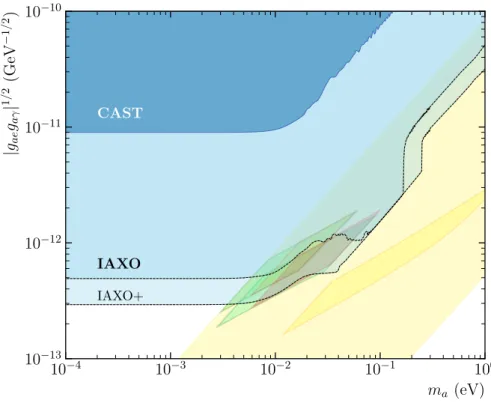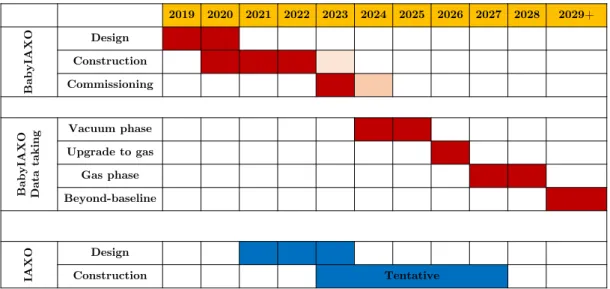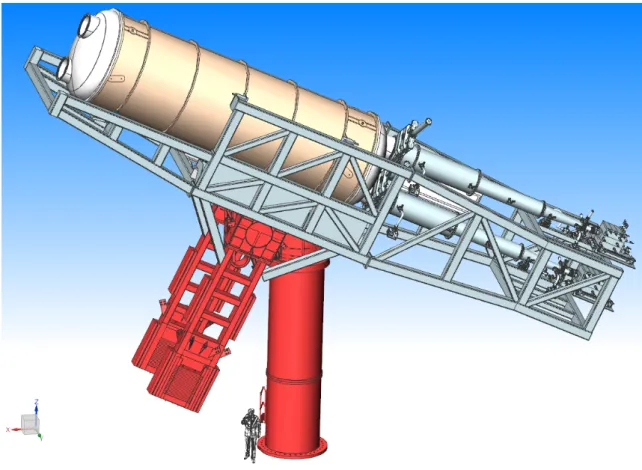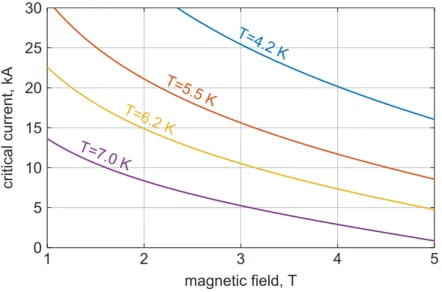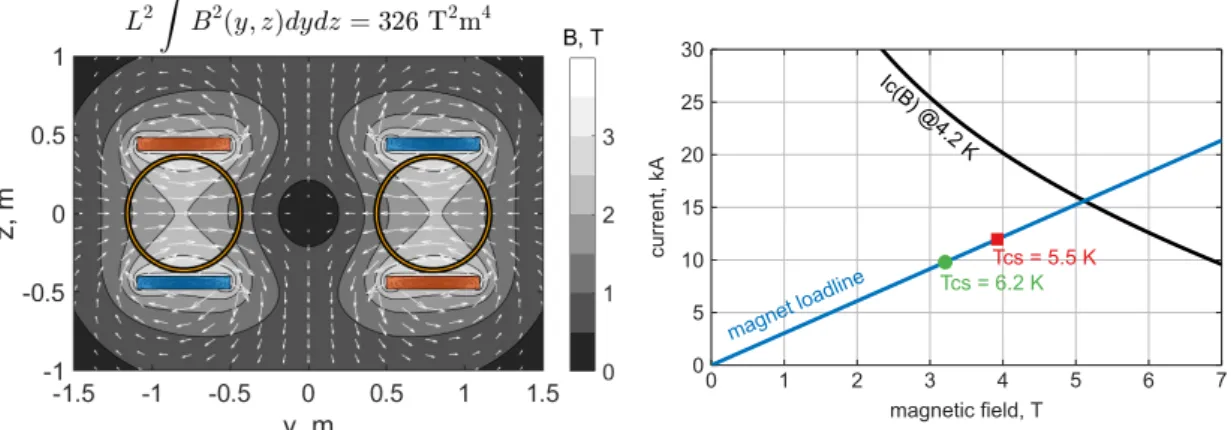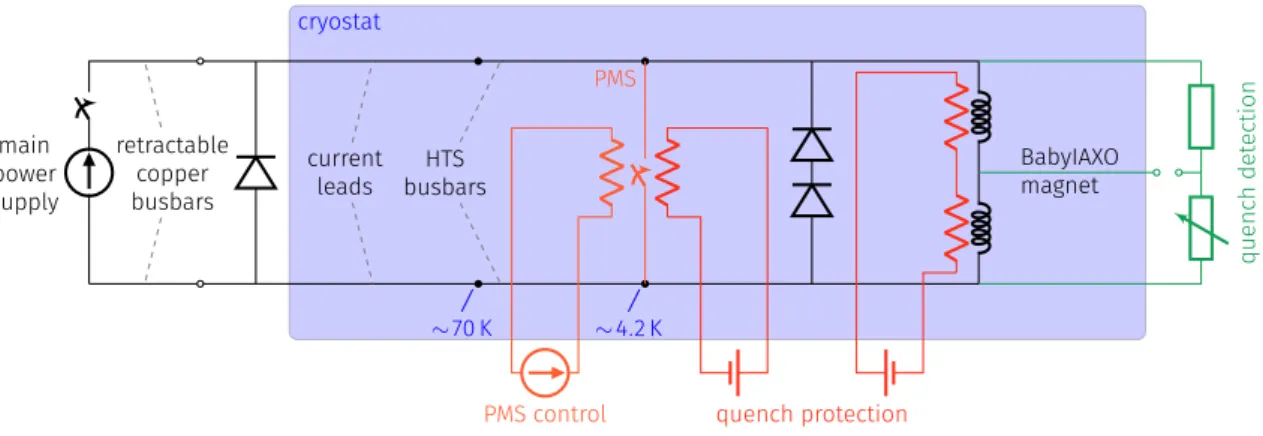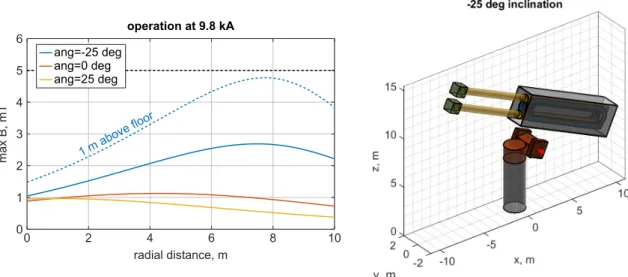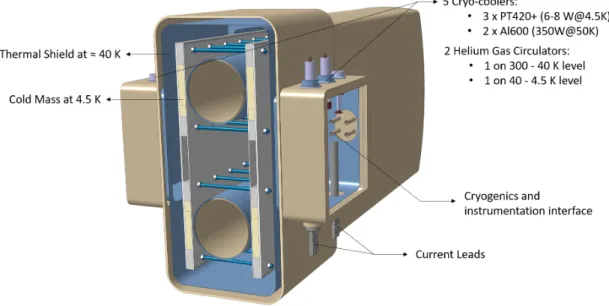Prepared for submission to JHEP
Conceptual Design of BabyIAXO, the intermediate stage towards the International Axion Observatory
IAXO collaboration
A. Abeln 1 , K. Altenm¨ uller 2 , S. Arguedas Cuendis 3 , E. Armengaud 4 , D. Atti´ e 4 , S. Aune 4 , S. Basso 5 , L. Berg´ e 6 , B. Biasuzzi 4 , P. T. C. Borges De Sousa 3 , P. Brun 4 , N. Bykovskiy 3 , D. Calvet 4 , J. M. Carmona 2 , J. F. Castel 2 , S. Cebri´ an 2 ,
V. Chernov 7,8 , F. E. Christensen 9 , M.M. Civitani 5 , C. Cogollos 10,11 , T. Dafn´ı 2 , A. Derbin 12 , K. Desch 13 , D. D´ıez 2 , M. Dinter 21 , B. D¨ obrich 3 , I. Drachnev 12 , A. Dudarev 3 , L. Dumoulin 6 , D. D. M. Ferreira 9 , E. Ferrer-Ribas 4 , I. Fleck 14 , J.
Gal´ an 2 , D. Gasc´ on 10,11 , L. Gastaldo 1 , M. Giannotti 15 , Y. Giomataris 4 , A. Giuliani 6 , S. Gninenko 8 , J. Golm 3,16 , N. Golubev 8 , L. Hagge 21 , J. Hahn 14 , C. J. Hailey 17 , D. Hengstler 1 , P. L. Henriksen 9 , T. Houdy 22,23 , R. Iglesias-Marzoa 18 , F. J. Iguaz 19 , I. G. Irastorza 2, ∗ , C. I˜ niguez 18 , K. Jakovˇ ci´ c 20 , J. Kaminski 13 , B. Kanoute 19 ,
S. Karstensen 21 , L. Kravchuk 8 , B. Laki´ c 20 , T. Lasserre 4 , P. Laurent 4 , O. Limousin 4 , A. Lindner 21 , M. Loidl 24 , I. Lomskaya 12 , G. L´ opez-Alegre 18 , B. Lubsandorzhiev 8 , K. Ludwig 21 , G. Luz´ on 2 , C. Malbrunot 3 , C. Margalejo 2 , A. Marin-Franch 18 , S. Marnieros 6 , F. Marutzky 21 , J. Mauricio 10,11 , Y. Menesguen 24 , M. Mentink 3 , S. Mertens 22,23 , F. Mescia 10,11 , J. Miralda-Escud´ e 10,25 , H. Mirallas 2 , J. P. Mols 4 , V. Muratova 12 , X. F. Navick 4 , C. Nones 4 , A. Notari 10,11 , A. Nozik 7,8 , L. Obis 2 , C. Oriol 6 , F. Orsini 19 , A. Ortiz de Sol´ orzano 2 , S. Oster 21 , H. P. Pais Da Silva 3 , V. Pantuev 8 , T. Papaevangelou 4 , G. Pareschi 5 , K. Perez 26 , O. P´ erez 2 ,
E. Picatoste 10,11 , M. J. Pivovaroff 27,28 , D. V. Poda 6 , J. Redondo 2 , A. Ringwald 21 , M. Rodrigues 24 , F. Rueda-Teruel 18 , S. Rueda-Teruel 18 , E. Ruiz-Choliz 29 , J. Ruz 27 , E. O. Saemann 21 , J. Salvado 10,11 , T. Schiffer 13 , S. Schmidt 13 , U. Schneekloth 21 , M. Schott 29 , L. Segui 4 , F. Tavecchio 5 , H. H. J. ten Kate 3 , I. Tkachev 8 , S. Troitsky 8 , D. Unger 1 , E. Unzhakov 12 , N. Ushakov 8 , J. K. Vogel 27 , D. Voronin 8 , A. Weltman 30 , U. Werthenbach 14 , W. Wuensch 3 , A. Yanes-D´ıaz 18
1 Heidelberg University, Kirchhoff Institute for Physics
2 Center for Astroparticles and High Energy Physics (CAPA), Universidad de Zaragoza, 50009 Zaragoza, Spain
∗
Corresponding author. IAXO Spokesperson. E-mail: irastorz@unizar.es
arXiv:2010.12076v2 [physics.ins-det] 22 Dec 2020
3 CERN - European Organization for Nuclear Research, Geneva, Switzerland
4 IRFU, CEA, Universit´ e Paris-Saclay, F-91191 Gif-sur-Yvette, France
5 INAF, Italian National Institute for Astrophysics, Osservatorio Astronomico di Brera, Milano/Merate, Italy
6 Universit´ e Paris-Saclay, CNRS/IN2P3, IJCLab, 91405 Orsay, France
7 Moscow Institute of Physics and Technology, Moscow, Russia
8 Institute for Nuclear Research of the Russian Academy of Sciences, 60th October Anniversary Prospect 7A, 117312, Moscow, Russia
9 Technical University of Denmark, DTU Space Kgs. Lyngby, Denmark
10 Institut de Ci` encies del Cosmos, Universitat de Barcelona, Barcelona, Spain
11 Departament de F´ısica Qu` antica i Astrof´ısica, Universitat de Barcelona, Barcelona, Spain
12 Petersburg Nuclear Physics Institute - NRC Kurchatov Institute, Gatchina, 188300, Russia
13 Physikalisches Institut der Universit¨ at Bonn, Nussallee 12, 53115 Bonn, Germany
14 Center for Particle Physics Siegen, Siegen University, Siegen, Germany
15 Physical Sciences, Barry University, 11300 NE 2nd Ave., Miami Shores, FL 33161, USA
16 Institute for Optics and Quantum Electronics, Friedrich Schiller University Jena, Jena, Germany
17 Columbia Astrophysics Laboratory, New York, U.S.A.
18 Centro de Estudios de F´ısica del Cosmos de Arag´ on, Plaza San Juan, Teruel, Spain
19 Synchrotron SOLEIL, 91192 Gif-sur-Yvette, France
20 Rudjer Boˇ skovi´ c Institute, Bijeniˇ cka cesta 54, 10000 Zagreb, Croatia
21 Deutsches Elektronen-Synchrotron DESY, Hamburg, Germany
22 Max-Planck-Institut f¨ ur Physik, F¨ ohringer Ring 6, 80805 M¨ unchen, Germany
23 Technische Universit¨ at M¨ unchen, James-Franck-Str. 1, 85748 Garching, Germany
24 CEA, LIST, Laboratoire National Henri Becquerel (LNE-LNHB), F-91191 Gif-sur-Yvette, France
25 ICREA, Barcelona, Spain
26 Massachusetts Institute of Technology, 77 Massachusetts Ave., Cambridge, MA 02139, USA
27 Lawrence Livermore National Laboratory, Livermore, CA, U.S.A.
28 SLAC National Accelerator Laboratory, Menlo Park, CA, U.S.A.
29 Johannes Gutenberg University, Mainz, Germany
30 High Energy Physics, Cosmology & Astrophysics Theory (HEPCAT) group, University of Cape Town, Private Bag, 7700 Rondebosch, South Africa
E-mail: Igor.Irastorza@unizar.es
Abstract: This article describes BabyIAXO, an intermediate experimental stage of the
International Axion Observatory (IAXO), proposed to be sited at DESY. IAXO is a large-
scale axion helioscope that will look for axions and axion-like particles (ALPs), produced
in the Sun, with unprecedented sensitivity. BabyIAXO is conceived to test all IAXO
subsystems (magnet, optics and detectors) at a relevant scale for the final system and
thus serve as prototype for IAXO, but at the same time as a fully-fledged helioscope with
relevant physics reach itself, and with potential for discovery. The BabyIAXO magnet will
feature two 10 m long, 70 cm diameter bores, and will host two detection lines (optics and
detector) of dimensions similar to the final ones foreseen for IAXO. BabyIAXO will detect
or reject solar axions or ALPs with axion-photon couplings down to g aγ ∼ 1.5 × 10 − 11
GeV − 1 , and masses up to m a ∼ 0.25 eV. BabyIAXO will offer additional opportunities
for axion research in view of IAXO, like the development of precision x-ray detectors to
identify particular spectral features in the solar axion spectrum, and the implementation
of radiofrequency-cavity-based axion dark matter setups.
Contents
1 Introduction 1
2 IAXO and BabyIAXO 3
2.1 Summary of IAXO physics case 5
2.2 BabyIAXO physics case 10
3 BabyIAXO as an intermediate goal towards IAXO 10
4 BabyIAXO magnet 13
4.1 Conductor and cold mass 14
4.2 Electrical circuit 19
4.3 Quench protection 21
4.4 Stray magnetic field and forces 22
4.5 Cryostat and Envelope 26
4.6 Cryogenics 29
4.7 Mains, vacuum pumps, cooling water and Magnet Control System 32
5 BabyIAXO optics 33
5.1 General considerations for the IAXO and BabyIAXO optics 33
5.2 Optics for BabyIAXO 35
5.2.1 Custom x-ray telescope for BabyIAXO 36
5.2.2 XMM flight-spare x-ray telescope for BabyIAXO 38 5.2.3 Alignment and Implementation of optics in BabyIAXO 41
6 BabyIAXO detectors 43
6.1 BabyIAXO requirements and state of the art 43
6.2 Micromegas detectors for BabyIAXO 45
6.2.1 Active and passive shielding 46
6.2.2 Gas system 48
6.2.3 Ultra thin windows 48
6.2.4 Mechanical design of the detector system and assembly proposal of
the detector system 48
6.2.5 Data acquisition electronics 51
6.3 Control of radiopurity and backgrounds 53
6.4 R&D of additional detector technologies 55
6.4.1 GridPix 56
6.4.2 MMCs 56
6.4.3 NTDs 57
6.4.4 TESs 57
6.4.5 SDDs 58
6.4.6 Axion DM detectors in BabyIAXO and IAXO 58
7 BabyIAXO structure and drive system 60
7.1 Requirements 60
7.2 Foundations 61
7.3 Positioner: tower, head and yokes 62
7.4 Mechanical elements of the drive assemblies 64
7.5 Support frame 65
8 BabyIAXO site and infrastructure 67
8.1 Civil engineering 67
8.2 HERA South Hall 68
8.3 Data acquisition and control 69
9 Conclusions 69
10 Acknowledgements 70
1 Introduction
Axions are necessary ingredients of the Peccei-Quinn (PQ) mechanism [1, 2], the most compelling solution to the strong CP problem of the Standard Model (SM) of particle physics. This problem arises from the fact that Quantum Chromodynamics (QCD) seems to be absent —at the current experimental precision— of CP-violating effects, while one would expect them. The PQ mechanism involves a new global U(1) chiral symmetry, now known as PQ (Peccei-Quinn) symmetry U(1) PQ , which is spontaneously broken at a large energy scale f a . The axion is the Nambu-Goldstone boson of the broken U(1) PQ symmetry [3, 4].
The phenomenological properties of the axion are mainly determined by the scale f a
and are closely related to those of the neutral pion. Due to the U(1) PQ symmetry not being exact at the quantum level, as a result of a chiral anomaly, the axion is not massless (although it is typically very light). The axion mass m a and all axion couplings to ordinary particles (photons, nucleons, electrons) are inversely proportional to f a .
In order to avoid accelerator-experiment-based constraints, f a must be much greater than the electroweak scale, thus making the axion very light, very weakly coupled, and very long-lived. Two classes of benchmark axion models are often referred to: KSVZ or hadronic axions [5, 6] and DFSZ or GUT axions [7, 8]. The main difference between the KSVZ and DFSZ-type axions is that the former do not couple to ordinary quarks and leptons at the tree level. Of course, many other possible axion models have been discussed in the literature [9], although the mentioned ones represent well the phenomenology at helioscopes.
Although the axion is the most studied prototype, a whole category of axion-like
particles (ALPs) or, more generically, weakly interacting slim particles (WISPs) appear
in extensions of the SM. ALPs can appear as pseudo Nambu-Goldstone bosons of new symmetries broken at high energy. Moreover, string theory also predicts a rich spectrum of ALPs. The phenomenology of axions and ALPs is close enough to permit their search for them with similar experiments. Of particular importance for experiments is that both axions and ALPs couple weakly to two photons, with the difference that for ALPs the coupling constant to photons g aγ is unrelated to the mass m a .
Axions are just as attractive a solution to the dark matter (DM) problem as weakly in- teracting massive particles (WIMPs). Relic axions can be produced thermally by collisions of particles in the primordial plasma, just like WIMPs. Being quite light particles, this axion population contributes to the hot DM component. Most interesting from the cos- mological point of view is the non-thermal production of axions: the vacuum-realignment mechanism and the decay of topological defects (axion strings and domain walls), both pro- ducing non-relativistic axions and therefore contributing to the cold DM. The non-thermal production mechanisms are generic to other bosonic WISPs such as ALPs or hidden pho- tons. In both cases a wide range of parameter space (in the case of ALPs g aγ -m a space) can contain models with adequate DM density, part of it at reach of current or future experiments.
Axions and ALPs have been searched for since their proposal 40 years ago, and remains elusive so far. Only recently the interest in axion searches is increasing substantially, as detection technologies have reached sensitivity to motivated regions of the axion parameters space. The experimental landscape is growing in diversity and size of projects [9]. The most prominent experimental strategies rely on the generic axion-photon coupling g aγ and the use of strong magnetic fields where axions can convert into photons that can be subsequently detected. There are three main categories of searches, that can be distinguished depending on the source of axions:
• laboratory experiments that search for axion-related phenomena produced entirely in the laboratory;
• helioscopes searching for axions that could be produced in various processes in the solar interior;
• haloscopes or other detectors directly sensitive to relic axions from the dark matter halo of our galaxy.
Conceptually elegant, as they do not rely on cosmological or astrophysical assumptions, laboratory experiments cannot however reach sensitivity to the g aγ values typically ex- pected for QCD axions. Haloscopes can reach sensitivity to QCD axions for some ranges of m a (while intense R&D is ongoing to extend it), although relying on the assumption that dark matter is (mostly) made of axions. For subdominant axion dark matter, the sensitivity of these experiments to g aγ must be scaled accordingly.
Helioscopes [10] look for axions and ALPs that could be emitted from the Sun and
therefore do not rely on the assumption of axions being dark matter candidates. The
emission of axions by the Sun is a generic prediction of most axion models and there-
fore helioscopes represent the only approach that combines a relative immunity to model
assumptions and a competitive sensitivity to parameters largely complementary to those accessible with other detection techniques. They use strong laboratory magnetic fields to convert solar axions into detectable x-ray photons with ∼ keV energies. Contrary to haloscopes, the helioscope sensitivity is independent on the axion mass up to relatively large values (up to ∼ 0.02 eV). The most advanced helioscope so far has been the CERN Axion Solar Telescope (CAST), active at CERN for more than 15 years [11–16]. During its last solar axion campaign, CAST obtained the most stringent limit on the axion-photon coupling g aγ [16], and hosted activities already in anticipation of the next generation axion helioscope. Most relevantly, this result was obtained in part thanks to the implemen- tation of the “IAXO pathfinder” detection line [17], including an x-ray telescope and a low-background Micromegas detector, both based on the same technologies proposed for International Axion Observatory (IAXO) [18].
Together with haloscopes, helioscopes are the only technique with proven sensitivity to explore realistic QCD axion models. An advantage of helioscopes is that there is a clear scaling strategy [18] to substantially push the present sensitivity frontline to lower values of g aγ and m a , a strategy that is implemented by the IAXO as detailed below.
2 IAXO and BabyIAXO
IAXO is a new generation axion helioscope designed to search for solar axions and ALPs with the axion-photon coupling g aγ and the axion-electron coupling g ae . Similarly IAXO will test models of other proposed particles at the low energy frontier of particle physics, like hidden photons or chameleons. In addition, the IAXO magnet has been designed to easily accommodate new equipment (e.g., microwave cavities or antennas) to search for relic axions. The discovery of the QCD axion or an ALP in the parameter space accessible by IAXO could have strong implications in other contexts of theoretical particle physics, cosmology and astrophysics.
As its primary physics goal, IAXO will look for axions and ALPs originating in the Sun (see Figure 1) and converted to photons in a laboratory magnetic field. These photons are then focused by x-ray telescopes into small focal spots that are imaged with low-background x-ray detectors [18]. The energies of these axions and ALPs fall in the range of about 1 keV to 10 keV. IAXO aims to improve the current CAST state-of-the-art by more than a factor of 10 4 in signal-to-noise ratio (SNR). In terms of sensitivity to g aγ , this represents an improvement of more than one order of magnitude with respect to current astrophysical and experimental upper bounds. This will allow to explore g aγ values down to 10 −12 GeV −1 for a wide range of axion masses. The current sensitivity curves in the g aγ − m a plane are shown in figure 2, for both BabyIAXO and IAXO. For the latter, two curves are shown:
the nominal projection (corresponding to the set of experimental parameters of the current
IAXO conceptual design [20]) and a possible improved scenario, referred to as IAXO+,
with an additional factor 10 better SNR, that could be potentially implemented after the
experience of the BabyIAXO stage. The values for the main experimental parameters for
both BabyIAXO and IAXO (and the latter for both nominal and improved scenarios) on
Compton
γ e
axio − deexcitation
I ∗
I a
axiorecombination
e
I I −
a
Primakoff
γ
e, I
a e
I
e − I bremsstrahlung
e
e − e bremsstrahlung
a e
a a
Figure 1. Feynman diagrams of the different processes responsible for axion production in the Sun.
The Primakoff conversion of photons in the electromagnetic fields of the solar plasma depends on the axion-photon coupling g aγ , and is present is practically every axion model. In non-hadronic models, in which axions couple with electrons at tree level, additional mechanisms of solar axion produc- tion are relevant, namely: atomic axio-recombination and axion-deexcitation, axio-Bremsstrahlung in electron-ion or electron-electron collisions and Compton scattering with emission of an axion.
Collectively, the flux of solar axions from all these latter g ae -mediated channels is sometimes called ABC solar axions, from the initials of the mentioned processes. Figure from ref [19].
which the aforementioned prospects are based, are listed in Table 1. The explanation and justification of these values can be found in [21].
IAXO sensitivity curves are the envelope of two data taking phases, Run-I and Run-II, each of them assuming 3 years exposure time. IAXO Run-I will be performed with vacuum in the magnet bores, and will determine the sensitivity of IAXO for axion masses below 0.01 eV. IAXO Run-II will use a 4 He buffer gas inside the magnet bores, with density continuously changed from 0 to 1 bar at room temperature. Run-II allows for improved sensitivity in the high mass range up to 0.25 eV. The particular distribution of exposure time in the different density steps is adjusted to achieve a sensitivity down to the DFSZ g aγ for each m a values, although other distributions are possible.
The BabyIAXO sensitivity line in figure 2 is also the envelope of two data taking campaigns, one in vacuum and one with buffer gas. A 1.5 year effective exposure is assumed for each of them. As in the case of IAXO, the gas phase exposure is distributed unequally in the various density steps to adjust the sensitivity to the KSVZ axion model g aγ for a relatively large mass range. We refer to [21] for more details of these sensitivity calculations.
As can be seen from figure 2, BabyIAXO should reach values of g aγ ∼ 1.5 × 10 − 11 GeV − 1 up to masses m a ∼ 0.02 eV. In the gas phase, BabyIAXO will extend to higher masses and in particular will probe KSVZ axions in the approximate range of about 0.06 to 0.25 eV.
IAXO will also be sensitive to non-hadronic axions with a coupling to electrons g ae ∼ 10 − 13
because it could detect the flux of solar axions originating from (electron-ion and electron-
Parameter Units BabyIAXO IAXO IAXO+
B T ∼ 2 ∼ 2.5 ∼ 3.5
L m 10 20 22
A m
20.77 2.3 3.9
f
MT
2m
4∼ 230 ∼ 6000 ∼ 24000
b keV
−1cm
−2s
−11 × 10
−710
−810
−9 d0.7 0.8 0.8
o0.35 0.7 0.7
a cm
22 × 0.3 8 × 0.15 8 × 0.15
t0.5 0.5 0.5
t year 1.5 3 5
Table 1. Indicative values of the relevant experimental parameters representative of BabyIAXO as well as IAXO. The parameters listed are the magnet cross-sectional area A, length L and magnetic field strength B, the magnet figure of merit f M = B 2 L 2 A, the detector normalized background b and efficiency d in the energy range of interest, the optics focusing efficiency or throughput o and focal spot area a, as well as the tracking efficiency t (i.e. the fraction of the time pointing to the sun) and the effetive exposure time. We refer to [21] for a detailed explanation and justification of these values.
electron) axion-Bremsstrahlung, Compton, and axio-deexcitation of ions [19] (together re- ferred to as BCA reactions). The energies of these axions fall in the range of about 0.5 − 2 keV. In this case the expected signal depends on g ae g aγ , the product of the electron cou- pling (responsible for the production in the Sun) and the photon coupling (responsible for the detection in IAXO). Not only could IAXO reach a sensitvity that will surpass the very stringent astrophysical bound on g ae for the first time for an experiment, but, as shown in figure 3, it could reach specific QCD axion models that may be hinted by anomalous astrophysical observations that are commented below.
2.1 Summary of IAXO physics case
A comprehensive review of the physics case of IAXO has recently been released by the collaboration [21]. We refer to it for a detailed explanation of the theoretical, cosmological and astrophysical motivation of the search for axions in the range of parameters at reach of IAXO, as well as a detailed discussion of the physics potential of the experiment. In the following we list and briefly summarize some of the major points:
• IAXO will enter into completely unexplored ALPs and axion parameter space. The
current experimental limit to g aγ competes with the best astrophysical bounds. IAXO
will push this limit more than one order of magnitude, in a wide mass range. At the
high-mass end of the parameter region IAXO will be able to explore a broad region
of realistic QCD axion models. Its sensitivity would cover axion models with masses
down to the few meV scale. IAXO is the only proposed technique able to probe a
large fraction of QCD axion models in the meV to eV mass band. This region is
10 − 9 10 − 8 10 − 7 10 − 6 10 − 5 10 − 4 10 − 3 10 − 2 10 − 1 10 0 10 1 m a (eV) 10 −17
10 − 16 10 − 15 10 − 14 10 −13 10 − 12 10 − 11 10 −10 10 − 9 10 − 8 10 − 7 10 −6
| g aγ | (GeV − 1 )
Helioscopes (CAST) Laboratory
HE γ-rays
Haloscopes KSVZ DSFZ
T elescop es
HB Sun
BabyIAXO IAXO ALPS-II
Figure 2. Sensitivity plot of IAXO and BabyIAXO in the primary g aγ -m a parameter space, compared with the QCD axion (yellow) band [22] and other current (solid) and future (dashed) experimental and observational limits (we refer to [9] for details on those limits). The yellow band represent the standard QCD axion models and the orange line the benchmark KSVZ model.
the only one in which astrophysical, cosmological (DM) and theoretical (strong CP problem) motivations overlap [24]. Already BabyIAXO will start probing unexplored parameter space, and thus there is potential for discovery already in this stage.
• Theory predicts that the Universe should be opaque to very-high-energy, VHE, pho- tons (i.e., photons with energies above 100 GeV) coming from distant emitters like ac- tive galactic nuclei (AGN) due to their non-negligible probability to interact with the background photons (EBL – extragalactic background light) permeating the Universe while traversing long intergalactic distances. However, several independent observa- tions seem to indicate that the Universe is too transparent for these photons [25–29].
Several authors [25, 26, 30–38] have suggested explanations of these observations by
invoking photon-ALP oscillations triggered by cosmic magnetic fields. Thus, the ALP
component can travel unimpeded through the intergalactic medium and as a result
the effective mean free path of the VHE photons increases. The required ALP mass
is m a ∼ 10 neV and coupling to photons g aγ ∼ 10 −11 GeV −1 . As shown in figure 2,
IAXO is sensitive to the entire parameter region where ALPs have been proposed to
10 − 4 10 − 3 10 − 2 10 − 1 10 0 m a (eV) 10 − 13
10 − 12 10 − 11 10 − 10
| g ae g aγ | 1 / 2 (GeV − 1 / 2 )
CAST
IAXO IAXO+
Figure 3. Sensitivity plot of IAXO to BCA (g ae -mediated) solar axions, in the ( | g ae g aγ | 1/2 -m a ) parameter space. The yellow band corresponds to the QCD axion models and the diamond-shaped color regions correspond to particular QCD axion models that are able to fit all the anomalous stellar cooling observations, following [23].
solve the VHE photon transparency problem, and BabyIAXO will already probe a large fraction of such region.
• A set of independent observations of diverse stellar systems have shown an excessive amount of energy loss, indicating a lack of understanding in the current modeling of stellar cooling (see Refs. [24, 39] for recent reviews). These deviations, often referred to as cooling anomalies, have been observed in: 1) white dwarfs (WDs), in which the cooling efficiency was extracted from the rate of the period change [40–
44]; 2) the WD luminosity function, which describes the distribution of WDs as a function of their brightness [45–47]; 3) red giant branch (RGB) stars, in particular the luminosity of the tip of the branch ∗ [49–51]; 4) horizontal branch (HB) stars or, more precisely, the R-parameter, i.e., the ratio of the number of HB over RGB stars [52, 53]; 5) helium burning supergiants, more specifically, the ratio (B/R) of blue and red supergiants [54, 55]; and 6) neutron stars [56–58]. The extra cooling mechanism via emission of light and weakly interacting axions/ALPs produced in the stellar core that are able to stream freely outside carrying energy away, provides a possible explanation of the cooling anomalies. Some of the anomalies require g ae
∗
Notice, however, that the recent analysis in Ref. [48] indicates no exotic energy loss.
at the few 10 −13 level, while g aγ around few 10 −11 GeV −1 is needed for others. It is remarkable that particular QCD axion models featuring both g ae and g aγ couplings are able to explain collectively all anomalies [23, 24, 59]. These models correspond to m a in the ballpark of 10 meV and could be probed by IAXO, as shown in figure 3. At lower masses, the hinted g aγ values overlap with the parameters required to explain the transparency hints. In all cases, IAXO shows a high potential to explore the relevant parameter space.
• Axions (and ALPs) are very compelling candidates to compose the cold dark matter.
The relic axion density depends on the cosmological history of the axion (in particular if the PQ symmetry breaks spontaneously before or after inflation) and on other axion model parameters, especially its mass. In general, a broad range of axion masses remains compatible with the correct relic density, including values above meV for the QCD axion that could be accessible by IAXO. Standard production of cold axions via the vacuum-realignment mechanism requires m a in the ballpark of m a ∼ 10 −5 eV, although if we allow for finetuning of the initial axion field value, a much larger m a
range is permitted. If the PQ symmetry is restored after inflation, model-dependent contribution of axion strings and domain-wall (DW) decays to axion DM must be taken into account, and are potentially dominant. According to the most recent numerical studies [60, 61], computation uncertainties still allow for a relatively large axion mass window, the upper part of which (m a ∼ meV) would be at reach of IAXO.
Moreover, models with long-lived DWs [62] would further increase the yield and point to QCD axions of 1 to 100 meV as those accounting for the totality of the Universe’s DM.
• In addition to the above, for all non-thermal production mechanisms the resulting relic axion density is approximately inversely proportional to the axion mass, ρ a ∼ m − a 1 , and therefore if axions are only a subdominant DM fraction the corresponding m a moves to larger values. Moreover, these mechanisms are generic to other ALP models. A large section of the parameter space accessible by IAXO contains ALP models with adequate DM density [63]. To summarize, although IAXO does not rely on axions to be the DM to detect them, it would be sensitive to axion models that could be part or all of the DM.
• The EDGES collaboration has recently observed [64] an anomalously strong 21-cm absorption line in the sky-averaged radio spectrum, corresponding to the era of first stars. This has been connected with possible cooling of the primordial hydrogen gas by interaction with dark matter. In particular, a small amount of axion dark matter could explain this observation [65, 66] within the context of standard models of axions and ALPs. This interpretation requires a QCD axion mass in the 100–450 meV range (slightly larger for ALPs). IAXO will have the capability to test a substantial part of the hinted region.
• Axions and ALPs are also invoked in cosmological scenarios other than cold DM. For
example, they can be also produced from thermal processes or from decays of heavy
particles, contributing to the relativistic degrees of freedom in the early Universe and potentially today. Current cosmological observations present some tension that could suggest the presence of Dark Radiation [67] (i.e. a cosmological relic of relativistic particles, with very weak interactions with the standard model). This could be in the form of axions or ALPs [68], whose abundance can be detectable by forthcoming cosmic microwave background (CMB) experiments [69, 70] especially if produced via interactions with quarks [71] or leptons [72]. These dark radiation axions/ALPs can feature a coupling to photons which is likely to be in the IAXO range and can thus be observed independently by IAXO for most values of the relevant parameters [71, 72].
• ALPs have masses protected by large radiative corrections and therefore it is very suggestive to use them as candidates for the inflaton field, whose slow-roll in a po- tential is thought to have driven primordial inflation. A recent scenario (dubbed the
“ALP miracle”) showed that, with an adequate potential and coupling to photons for reheating, an ALP with the parameters in the approximate ranges m a ∼ 0.01–1 eV and g aγ ∼ 10 − 11 -10 − 10 GeV − 1 , accessible to IAXO, could be responsible for cosmic inflation, and simulaneously be the DM candidate [73, 74].
• ALPs in the early Universe have also been proposed as an explanation of the ob- served baryon asymmetry of the Universe. A particularly interesting framework is the recently proposed “ALP cogenesis”[75], in which the ALP gets an initial field velocity that delays the beginning of the oscillation of the ALP around the minimum of the potential, and enhances the ALP abundance in comparison with the conven- tional misalignment mechanism. The couplings required to explain both DM and the baryon asymmetry are much larger than those of the QCD axion. Part of the predicted region of parameter space is at reach of IAXO.
• It must be stressed that IAXO’s sensitivity goals do not depend on the hypothesis of axion being the DM, i.e. the sensitivity only relies on the axion emission by the Sun, a firm prediction of most axions models. Therefore, in case of non-detection, IAXO will provide a robust exclusion of the corresponding regions of ALP/axion parameter space.
• In the case of a positive detection, IAXO may also determine details of the underlying
model, given sufficient signal statistics. For m a higher than around 0.02 eV, axion-
photon oscillations destroy the coherence of the conversion along the magnet. This
coherence can be restored by the buffer gas technique, providing a way to measure
m a . For masses as low as 3 × 10 − 3 eV the onset of these spectral oscillations can be
observed and used to determine the axion mass [76]. Moreover, if the axion signal is
composed by significant fractions of Primakoff and ABC solar axions, the combined
spectral fitting can provide independent estimations of g aγ and g ae [77]. To exploit
these capabilities high-resolution and low-threshold detectors are preferred, and this
motivates the multi-detector R&D program being undertaken within IAXO.
• IAXO will also constitute a generic infrastructure for axion/ALP physics with poten- tial for additional search strategies. Most relevant is the possibility of implementing haloscope-like setups (e.g. based on the use of RF cavities) to search for DM axions.
The BabyIAXO magnet will already surpass the haloscope figure of merit (B 2 V ) of the magnets currently in use for haloscope searches, while the IAXO magnet will enjoy a figure of merit one order of magnitude larger.
2.2 BabyIAXO physics case
All of the points above stated apply to BabyIAXO, to a correspondingly lower extent.
BabyIAXO will enjoy sensitivity to axions and ALPs down to g aγ ∼ 1.5 × 10 −11 GeV −1 (for m a . 0.02 eV) and therefore will already enter unexplored space, as shown in fig- ure 2. At the high mass part of this region, BabyIAXO will probe QCD axion models. In particular, making use of the buffer gas technique, BabyIAXO will find or exclude KSVZ axions between 70 and 250 meV. Part of this region is motivated by the stellar cooling anomalies mentioned above. Also these parameters partially overlap with the ones invoked in the “ALP miracle” models and in the axion dark matter interpretation of the EDGES anomalous observation, both mentioned above. At lower masses, BabyIAXO will probe a large fraction of the region of parameters invoked to solve the anomalous observations of the transparency of the Universe to VHE photons. The generic arguments involving ALPs from higher energy extensions of the SM, the ALP as dark matter, etc. are also generi- cally applicable to BabyIAXO. To summarize, BabyIAXO will probe a relevant region of so-far-unexplored parameter space, and a discovery is not excluded already at this stage.
3 BabyIAXO as an intermediate goal towards IAXO
BabyIAXO is conceived as a first experimental stage towards IAXO, with the two- fold objective of: 1) being a technological prototype of IAXO, mitigating risks and better preparing the ground for IAXO, and 2) producing intermediate but relevant physics out- comes, allowing the collaboration to promptly move into “experiment” mode. These two considerations have been the guidance to define the conceptual design for BabyIAXO. In addition, it is expected that the experience of building and operating the BabyIAXO sys- tems will offer opportunities of improvement of one or more of the baseline experimental parameters, and therefore lead to an enhanced IAXO figure of merit with respect to the current design. The possibility of exploring incremental improvements of the different BabyIAXO subsystems will be taken into account whenever possible, provided it does not jeopardize the baseline physics program.
The BabyIAXO magnet is based on a “common coil” layout, i.e. two parallel flat
racetrack coils with opposite current directions. In between the coils two parallel 70-cm
diameter bores are placed. Unlike in the IAXO toroidal design, the two bores are located
between the racetrack sides, where a relatively high (mostly dipolar) field is produced. As
discussed in section 4, with a length of 10 meters, the chosen configuration already provides
a magnet figure of merit more than 10 times higher than that of the CAST magnet, allowing
for the relevant physics outcome discussed in the previous section. At the same time, and
despite the differences with the IAXO toroidal design, the BabyIAXO superconducting coils enjoy very similar engineering parameters (winding, geometry, etc.) as those of the final IAXO toroidal design, and therefore they constitute relevant technological prototypes of the latter.
The two BabyIAXO magnet bores will be equipped with two detection lines, each one composed by an x-ray optics and a low-background detector, of dimensions and parameters representative of the ones foreseen for IAXO. In fact, comparing with the dimensions set in the IAXO conceptual design report [20], the BabyIAXO lines target a slightly larger diameter (70 cm versus 60 cm). This decision takes advantage of the availability of XMM spare optics of 70 cm diameter, and therefore does not constitute a risk for the physics goals of BabyIAXO. At the same time, it gives the opportunity to the collaboration to face the challenges associated with building the IAXO optics larger than the dimensions foreseen in the IAXO CDR (60 cm was then considered a safe, within-state-of-the-art, design choice) and develop the ingredients that will eventually contribute to push the figure of merit of the final IAXO. The baseline configuration foreseen for the BabyIAXO optics includes one XMM (X-ray Multi-mirror Mission) spare optics and one newly-built IAXO optics. Both devices are described in detail in section 5. This decision is a good compromise between the best physics outcome of BabyIAXO and the opportunity to build and operate a prototype IAXO optics.
At the focal points of both optics, BabyIAXO will host two low-background pixelated x-ray detectors. The baseline technology for these detectors are small ( ∼ 6 cm wide and
∼ 3 cm thick) gaseous chambers read by pixelated planes of micro-mesh gas structures (Micromegas) [78] manufactured with the microbulk technique [79]. These detectors have been successfully used and developed in CAST and other low background applications [80], and is the outcome of many years of development towards low radioactive background. The detector’s components are built of very radiopure materials and they are surrounded by passive (lead and copper) and active (muon vetoes) shielding to reduce external radiation.
A pathfinder system combining an X-ray optics of the same type as proposed for IAXO and a Micromegas detector has been operated in CAST during 2014 and 2015 with the expected performance [17]. The BabyIAXO Micromegas detectors constitute representative prototypes of the final detectors proposed for IAXO. The target background for these detectors are at least 10 − 7 counts keV − 1 cm − 2 s − 1 and possibly lower, and a threshold of at least 1 keV. The plans to build two such detectors for BabyIAXO are described in detail in section 6.
In addition to the baseline detectors, a number of alternative or additional detection
technologies are being developed. Although less developed that microbulk Micromegas from
the point of view of low background, they outperform the latter in terms of energy threshold
or resolution. GridPix detectors, similar to Micromegas detectors but built on a small
CMOS pixelized readout [81], enjoy energy thresholds down to the tens of eV, and thus are
of interest for the search of specific solar axion production channels lying at lower energies,
like the ones mediated by the axion-electron coupling. Silicon Drift Detectors (SDD) offer
better energy resolution with flexible and cost-effective implementations [82, 83]. Finally,
bolometric detectors like Magnetic Metallic Calorimeters (MMC) [84], or Transition Edge
2019 2020 2021 2022 2023 2024 2025 2026 2027 2028 2029+
Ba by IA X O Design Construction Commissioning
Ba by IA X O D at a tak in g Vacuum phase Upgrade to gas
Gas phase Beyond-baseline
IA X O Design
Construction Tentative
Figure 4. Tentative timeline for construction and operation of BabyIAXO, showing the intended start of data taking by 2024.
Sensors (TES) [85, 86], enjoying outstandingly low energy threshold and energy resolution, are also under consideration. Plans to test and develop all these technologies in specific detector platforms, and assess them for their potential use in IAXO, are discussed in section 6. Depending on the results of such developments, BabyIAXO could host one or more of these prototypes in subsequent beyond-baseline data taking campaigns. Eventually, the results of these developments will feed the final IAXO technical design. Ideally IAXO could host an optimal suite of different detection techniques, combining figure of merit and the robustness of different detectors (with different systematics). Needless to say, in the event of a discovery, the focus of the experiment would shift from “discovery” detectors (priority to low background) to “high-precision measurement” detectors (high spatial and energy resolutions). In this respect, we need to stress that the capability of (Baby)IAXO to determine the axion parameters once a positive detection is produced (see previous section) rely to some extent on the availability of high energy resolution and low-threshold detectors. If a discovery happens already in BabyIAXO, IAXO could be equipped from the start with high-resolution detectors, given that IAXO will enjoy a signal-to-noise ratio
∼ 10 − 2 times larger than BabyIAXO.
Beyond serving as a prototype for everyone of the IAXO subsystems, BabyIAXO will constitute an invaluable preparatory exercise for the overall infrastructure. It will test all interfaces of relevance for IAXO, and the long-term stability of the systems. It will help create intangible resources that will be useful also for IAXO, like e.g. software and analysis tools, collaboration structure and data taking protocols. All of them will be naturally extended over to the IAXO phase.
The BabyIAXO stage has recently been approved to be hosted at DESY, and the
collaboration is already taking first steps towards its construction. The intended timeline
is shown in Figure 4. As shown, BabyIAXO could start its first data taking in 2024.
The physics prospects presented in the last section for BabyIAXO are computed assuming the baseline configuration and two data taking campaigns (one in vacuum and one with a buffer gas) of about two years of duration each. After this first physics campaign, and hopefully in parallel with the construction and commissioning of the full IAXO experiment, the BabyIAXO infrastructure will be available to assist the preparatory actions for IAXO.
This actions may include tests with new detectors like the ones mentioned in the previous paragraph or new type of equipment, like RF-cavity-based setups sensitive to relic axions.
The precise planning of this experimental phase will be configured once the development lines, as well as the IAXO design and construction plans, are more advanced.
4 BabyIAXO magnet
The main requirements for the design of the BabyIAXO superconducting detector magnet system were identified at the early stage of the project in December 2017. They comply with the guidelines exposed in the previous section combining “prototyping” and
“physics” aspects, and are set in coherence with those for the full-size IAXO magnet system, namely: 1) the target performance of the magnet, in terms of the magnet figure of merit (MFOM † ), is set to at least 10 times higher than that of the CAST magnet MFOM;
2) simple and robust design options must be chosen to allow construction within 3 to 4 years; and 3) a lowest-cost design is required to limit the magnet construction budget to a reasonable level of some ∼ 3 M € .
As a result of the assessment of various technical options for magnet and cryogenics, the principal solutions for the BabyIAXO magnet were fixed as follows, regarding:
• conductor: NbTi Rutherford cable co-extruded with a pure aluminum matrix with 2 K temperature margin;
• coil windings: two flat racetrack coils of 10 m length arranged in a common-coil layout;
• detection bore: two 700 mm free-bore tubes;
• electrical operation: persistent current mode with power supply switched off after charging;
• cooling mode: conduction cooled at 4.2 K using cryocirculators;
• cryogenics: use of cryocoolers for cool down and stationary operation (dry cooling condition).
Details and implications of the selected approach for BabyIAXO are presented in the following sections. A CAD overview of the entire BabyIAXO experiment is shown in Figure 5.
†
![Figure 2. Sensitivity plot of IAXO and BabyIAXO in the primary g aγ -m a parameter space, compared with the QCD axion (yellow) band [22] and other current (solid) and future (dashed) experimental and observational limits (we refer to [9] for details on tho](https://thumb-eu.123doks.com/thumbv2/1library_info/3995647.1540050/10.892.190.685.132.573/figure-sensitivity-babyiaxo-primary-parameter-compared-experimental-observational.webp)
